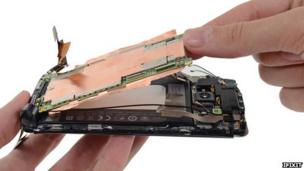A new mobile phone concept that would give users a chance to choose from a range of components, and replace or upgrade them when necessary, has generated enormous interest online. But could this sustainable, modular device ever become a reality?
Six months ago, the Dutch designer Dave Hakkens took apart his favourite camera.
"I noticed all these little parts," he says. "And everything was good except for the lens motor. That had broken."
But when Hakkens contacted the manufacturer to get a replacement motor, he was advised to just replace the whole camera. "With your bike you repair the tyre, you don't throw the bike away," he says. "But for some reason this is what we do with electronics."
Hakkens realised that if a device could be taken apart and upgraded more easily it would last much longer, minimising electrical waste. And so the idea of Phonebloks was born.
The concept - Hakkens hasn't figured out how to actually make it - is for a phone with a replaceable screen and easily moveable, changeable "bloks", each containing a different element such as battery, chipset, gyroscope and so on.
The bits fall into place on the backplate of the phone like pieces of Lego. The bloks vary in size and can be made to tessellate in any number of combinations.
"Let's say this is your phone and you do everything in the cloud - why not replace your storage blok with a bigger battery blok?" asks the voiceover. "If you're like this guy and love to take pictures, why not upgrade your camera?"
Last month, Hakkens set about showing off Phonebloks using the "crowd speaking" platform Thunderclap. Users donate their social reach to a project they support, allowing the site to commandeer their Twitter, Tumblr and Facebook accounts to broadcast a message at a single, predetermined moment.
Hakkens was aiming for 500 people to sign up to his Thunderclap, but the Phonebloks video went viral, gaining seven million views in three days. He has now amassed 950,000 Thunderclap supporters and on Tuesday the Phonebloks video will ping across social networks 375 million times.
"It comes down to a consumer signal," says Kyle Wiens, the founder of iFixit.com, a repository for user-generated repair manuals to the latest gadgets. "The market needs to indicate to manufacturers that we care about modular, repairable hardware."
Phones have never been as modular as computers, but Wiens says they used to be sturdier and more repairable.
Take batteries. Until the iPhone came along in 2007, batteries on all handsets could be readily removed. With every new phone the power source is a little bit harder to get to, stuck down with more glue, or tucked away in a case that's more impregnable. To get the battery out of the HTC One.
"I wish batteries were more replaceable than they are," says Bruce Harvey, an electrical engineer at Florida State University. "The reason they're not is in order to make the phone so small, the battery's shape is conformed to fit in there, rather than be a square block [like Phonebloks]."
It is consumer preference for a small phone that has pushed manufacturers to hide their batteries away. In the same way, our craving for ever-slimmer, speedier phones has led them to pile hardware - such as the central processor, memory and wifi - on to the same chip, not separate them out into blocks.
Harvey believes that Phonebloks is a technical challenge but an achievable one. The bloks could talk to one another if they were all designed to work with the same signalling system. However, he says the real difficulty would be in making a modular phone robust enough to survive the "harsh environment" of the trouser pocket. Each component would have to be encased in a material such as plastic, adding thickness and making the device less sexy.
"It's one of those things where if people look at it they say, 'Wow, I can be more ecologically sound, I get upgrades when I want to…'" he says. "Then someone shows them that their phone's going to be six-tenths of an inch (1.5cm) thick or something like that. Reality will meet up with hopes and dreams."
The challenge of marketing a modular system doesn't end with the chubbiness problem.
"We sadly live in a disposable society and people do have an expectation that they will change their phone every so often," says Ben Wood, an analyst at CCS Insight (and proud owner of more than 800 handsets going back two decades).
How long people hang on to a handset varies across the world. On average it's just over three years, but in the US it's just 20 months.
Although new devices are almost always bought on a contract, people have come to regard their new phone as a "free upgrade". Lots of us wait impatiently for upgrade day - phone technology is advancing so fast that multiple components, though still functional, feel outdated after a couple of years.
However, this trend may not continue indefinitely, Wood says. Mobile phones could be approaching an "innovation plateau" where the basics like speed and screen resolution are as good as they can get. Add to this the regular software "drops" that make our phones feel like new, and people might start hanging on to their handsets for longer. In this kind of market, Phonebloks might become viable, Wood argues.
Home computers reached an innovation plateau some years ago, but while we replace our computers less frequently than we used to, not many of us exploit the modular nature of our PCs and upgrade the modules. However, in Hakkens's view that's because it isn't easy enough - only "die-hard geeks" are willing to reach for a screwdriver to unscrew their memory or motherboard.
Price is arguably the least important factor in the mobile phone market, but it may represent another challenge for Phonebloks.
In the long run, you might think consumers would save money with a modular system that can be continually upgraded and never needs chucking out, but this may not be the case.
Big phone companies achieve enormous efficiencies of scale by negotiating special rates with parts manufacturers, buying up production capacity for months at a time. In return, the parts manufacturers get investment for research and development and a guarantee of future business.
The idea of marketing "bloks" to end-consumers through a "blokstore" might not be so appealing to these companies, which might in turn prevent similar economies of scale being achieved.
Hakkens recognises that neither the big phone companies nor the manufacturers that work with them are likely to jump at his idea - he sees it as a chance for other electronics companies to enter the fray. He says he has been approached by a number of companies and individuals excited about getting involved.
"Right now, I'm thinking about what would be the best next step," he says. "Would it be to build it myself, open-source, online - or partner up with companies and collaborators?"
He seems to have been caught off guard by the attention his little idea is receiving. "I wasn't planning to do a next step," he admits, "but now I have all these people offering help."
Kyle Wiens and Ben Wood are enthusiastic about Phonebloks, but they both believe the concept might end in a half-way house - a phone in which the battery and screen, and possibly the memory and camera, can be easily replaced. For Wiens, the key to making a green phone is different - a design durable enough for the device to reach a second-hand market.
"The whole phone doesn't need to be modular so long as it can be repaired and kept in service," he says.
Dave Hakkens doesn't pretend to have all the answers, or even certainty that Phonebloks will see the light of day.
Posted by www.anymobilesmartphone.co.uk






